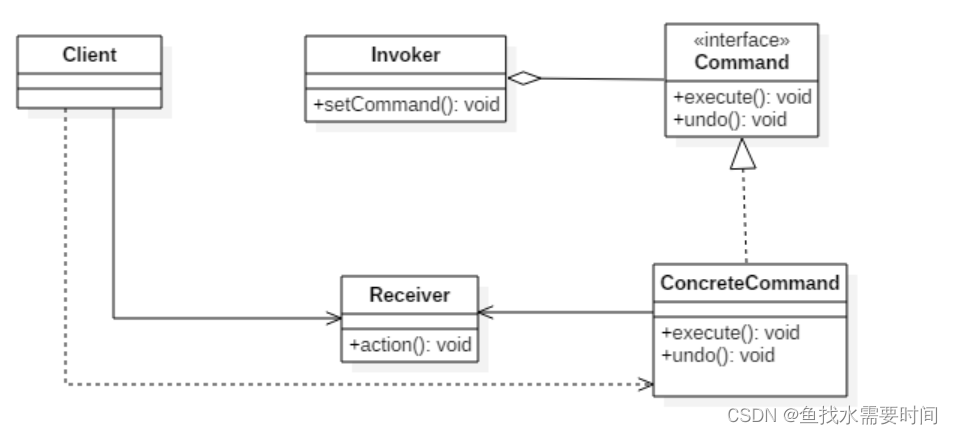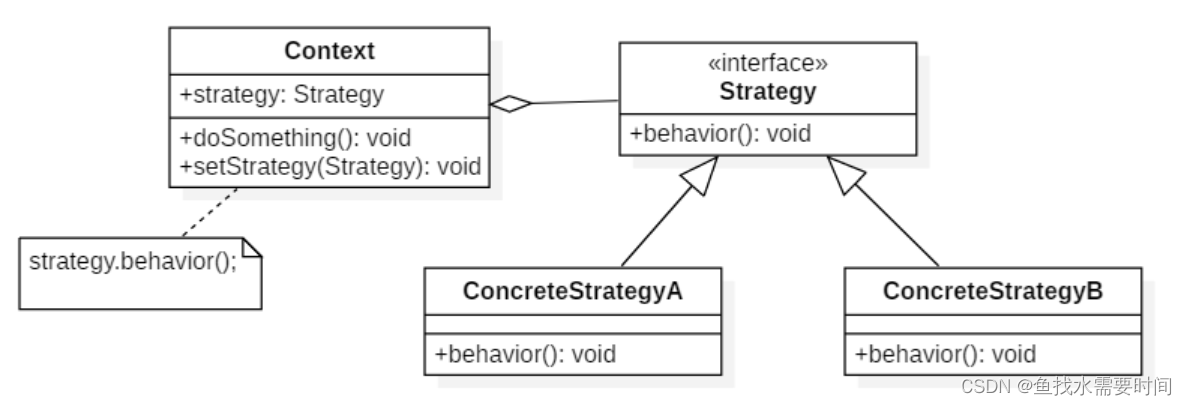最为常见的是代码中使用很多的if/else,或者switch/case;如何重构呢?方法特别多
- 出现if/else和switch/case的场景
- 重构思路
- 方式一 - 工厂类
- 方式二 - 枚举
- 方法三 - 命令模式
- 方法四 - 规则引擎
- 方法五 - 策略模式
- 一些反思
出现if/else和switch/case的场景
通常业务代码会包含这样的逻辑:每种条件下会有不同的处理逻辑。比如两个数a和b之间可以通过不同的操作符(+,-,*,/)进行计算,初学者通常会这么写:
public int calculate(int a, int b, String operator) {
int result = Integer.MIN_VALUE;
if ("add".equals(operator)) {
result = a + b;
} else if ("multiply".equals(operator)) {
result = a * b;
} else if ("divide".equals(operator)) {
result = a / b;
} else if ("subtract".equals(operator)) {
result = a - b;
}
return result;
}或者用switch/case:
public int calculateUsingSwitch(int a, int b, String operator) {
switch (operator) {
case "add":
result = a + b;
break;
// other cases
}
return result;
}这种最基础的代码如何重构呢?
重构思路
有非常多的重构方法来解决这个问题, 这里会列举很多方法,在实际应用中可能会根据场景进行一些调整;另外不要纠结这些例子中显而易见的缺陷(比如没用常量,没考虑多线程等等),而是把重心放在学习其中的思路上。
方式一 - 工厂类
- 定义一个操作接口
public interface Operation {
int apply(int a, int b);
}- 实现操作, 这里只以add为例
public class Addition implements Operation {
@Override
public int apply(int a, int b) {
return a + b;
}
}- 实现操作工厂
public class OperatorFactory {
static Map<String, Operation> operationMap = new HashMap<>();
static {
operationMap.put("add", new Addition());
operationMap.put("divide", new Division());
// more operators
}
public static Optional<Operation> getOperation(String operator) {
return Optional.ofNullable(operationMap.get(operator));
}
}- 在Calculator中调用
public int calculateUsingFactory(int a, int b, String operator) {
Operation targetOperation = OperatorFactory
.getOperation(operator)
.orElseThrow(() -> new IllegalArgumentException("Invalid Operator"));
return targetOperation.apply(a, b);
}对于上面为什么方法名是apply,Optional怎么用? 请参考:Java 8 - 函数编程(lambda表达式)
方式二 - 枚举
枚举适合类型固定,可枚举的情况,比如这的操作符; 同时枚举中是可以提供方法实现的,这就是我们可以通过枚举进行重构的原因。
- 定义操作符枚举
public enum Operator {
ADD {
@Override
public int apply(int a, int b) {
return a + b;
}
},
// other operators
public abstract int apply(int a, int b);
}- 在
Calculator中调用
public int calculate(int a, int b, Operator operator) {
return operator.apply(a, b);
}- 写个测试用例测试下:
@Test
public void whenCalculateUsingEnumOperator_thenReturnCorrectResult() {
Calculator calculator = new Calculator();
int result = calculator.calculate(3, 4, Operator.valueOf("ADD"));
assertEquals(7, result);
}
是否很简单?
方法三 - 命令模式
命令模式也是非常常用的重构方式, 把每个操作符当作一个Command。
- 命令模式(Command pattern): 将"请求"封闭成对象, 以便使用不同的请求,队列或者日志来参数化其他对象. 命令模式也支持可撤销的操作。
-
Command: 命令 -
Receiver: 命令接收者,也就是命令真正的执行者 -
Invoker: 通过它来调用命令 -
Client: 可以设置命令与命令的接收者

-
Command接口
public interface Command {
Integer execute();
}- 实现
Command
public class AddCommand implements Command {
// Instance variables
public AddCommand(int a, int b) {
this.a = a;
this.b = b;
}
@Override
public Integer execute() {
return a + b;
}
}- 在
Calculator中调用
public int calculate(Command command) {
return command.execute();
}- 测试用例
@Test
public void whenCalculateUsingCommand_thenReturnCorrectResult() {
Calculator calculator = new Calculator();
int result = calculator.calculate(new AddCommand(3, 7));
assertEquals(10, result);
}
注意,这里new AddCommand(3, 7)仍然没有解决动态获取操作符问题,所以通常来说可以结合简单工厂模式来调用:
- 创建型 - 简单工厂(
Simple Factory)
- 简单工厂(Simple Factory),它把实例化的操作单独放到一个类中,这个类就成为简单工厂类,让简单工厂类来决定应该用哪个具体子类来实例化,这样做能把客户类和具体子类的实现解耦,客户类不再需要知道有哪些子类以及应当实例化哪个子类
方法四 - 规则引擎
规则引擎适合规则很多且可能动态变化的情况,在先要搞清楚一点Java OOP,即类的抽象:
- 这里可以抽象出哪些类? 头脑中需要有这种自动转化
- 规则
Rule
- 规则接口
- 具体规则的泛化实现
- 表达式
Expression
- 操作符
- 操作数
- 规则引擎
- 定义规则
public interface Rule {
boolean evaluate(Expression expression);
Result getResult();
}- Add 规则
public class AddRule implements Rule {
@Override
public boolean evaluate(Expression expression) {
boolean evalResult = false;
if (expression.getOperator() == Operator.ADD) {
this.result = expression.getX() + expression.getY();
evalResult = true;
}
return evalResult;
}
}- 表达式
public class Expression {
private Integer x;
private Integer y;
private Operator operator;
}- 规则引擎
public class RuleEngine {
private static List<Rule> rules = new ArrayList<>();
static {
rules.add(new AddRule());
}
public Result process(Expression expression) {
Rule rule = rules
.stream()
.filter(r -> r.evaluate(expression))
.findFirst()
.orElseThrow(() -> new IllegalArgumentException("Expression does not matches any Rule"));
return rule.getResult();
}
}- 测试用例
@Test
public void whenNumbersGivenToRuleEngine_thenReturnCorrectResult() {
Expression expression = new Expression(5, 5, Operator.ADD);
RuleEngine engine = new RuleEngine();
Result result = engine.process(expression);
assertNotNull(result);
assertEquals(10, result.getValue());
}
方法五 - 策略模式
策略模式比命令模式更为常用,而且在实际业务逻辑开发中需要注入一定的(比如通过Spring的@Autowired来注入bean),这时通过策略模式可以巧妙的重构
- 策略模式(strategy pattern): 定义了算法族, 分别封闭起来, 让它们之间可以互相替换, 此模式让算法的变化独立于使用算法的客户
-
Strategy 接口定义了一个算法族,它们都具有 behavior() 方法。 -
Context 是使用到该算法族的类,其中的 doSomething() 方法会调用 behavior(),setStrategy(in Strategy) 方法可以动态地改变 strategy 对象,也就是说能动态地改变 Context 所使用的算法。

- Spring中需要注入资源重构?
如果是在实现业务逻辑需要注入框架中资源呢?比如通过Spring的@Autowired来注入bean。可以这样实现:
- 操作 很巧妙
public interface Opt {
int apply(int a, int b);
}
@Component(value = "addOpt")
public class AddOpt implements Opt {
@Autowired
xxxAddResource resource; // 这里通过Spring框架注入了资源
@Override
public int apply(int a, int b) {
return resource.process(a, b);
}
}
@Component(value = "devideOpt")
public class devideOpt implements Opt {
@Autowired
xxxDivResource resource; // 这里通过Spring框架注入了资源
@Override
public int apply(int a, int b) {
return resource.process(a, b);
}
}- 策略
@Component
public class OptStrategyContext{
private Map<String, Opt> strategyMap = new ConcurrentHashMap<>();
@Autowired
public OptStrategyContext(Map<String, TalkService> strategyMap) {
this.strategyMap.clear();
this.strategyMap.putAll(strategyMap);
}
public int apply(Sting opt, int a, int b) {
return strategyMap.get(opt).apply(a, b);
}
}
上述代码在实现中非常常见。
反思
最怕的是刚学会成语,就什么地方都想用成语。
- 真的要这么重构吗?
- 在实际开发中,
切记最怕的是刚学会成语,就什么地方都想用成语; 很多时候不是考虑是否是最佳实现,而是折中(通常是业务和代价的折中,开发和维护的折中…),在适当的时候做适当的重构。 - 很多时候,让团队可持续性的维护代码便是最佳;
- 重构后会生成很多类,一个简单业务搞这么复杂?所以你需要权衡










